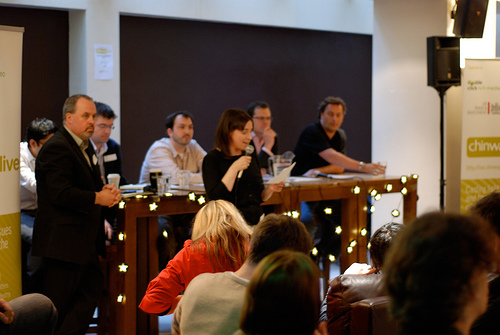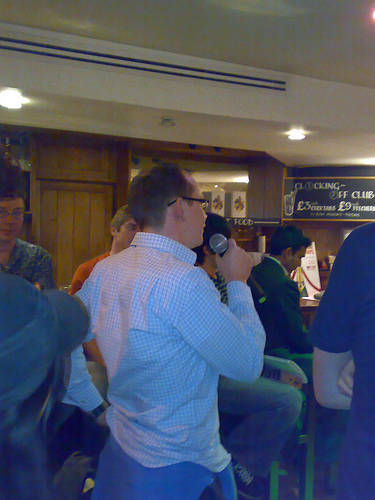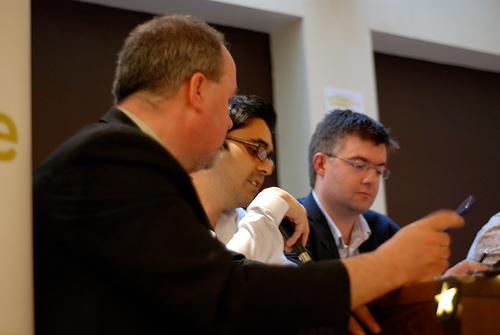Micromedia makes my life better. For one thing – I don’t have to take comprehensive notes at Chinwag events, because there’s always the trusty podcast 🙂 Thus I spent more of this event using my more evolved faculties of listening and thinking. Amen to that!

L-R: Umair Haque, Steve Bowbrick, Neil McIntosh (The Guardian), Mitch McAlister (MySpace), Deirdre Molloy (Chinwag), Miles Lewis (Last.fm), Gerd Leonhard
Another good thing about micromedia is that it can re-combine or aggregate into different – often richer – things than its constituent ingredients. The whole is indeed greater… usually. And that’s exactly what happened at Chinwag Live Micro Media Maze last Tuesday 20th May.
PANEL
Umair Haque – Director, Havas Media Lab / Bubblegeneration
Gerd Leonhard – Media Futurist, Author, Entrepreneur
Mitch McAlister – Product Director (Europe), MySpace
Miles Lewis – SVP, European Advertising Sales, LastFM
Neil McIntosh – Head of Editorial Development, Guardian Unlimited
Chair: Steve Bowbrick
From the premise of widgets, and disaggregated, widgetised media more generally – it quickly took off into a much broader debate about the value of media, the challenges for advertising, and the potential of openness for brands, innovators and society more generally.
That’s an exciting leap – and it’s alchemy in my book. Like a previous event we held in Manchester in April – User Centred Advertising – raising bigger questions and breaking out of the ‘media as entertainment’ mindset triggered a much more stimulating conversation with the audience and pointed to an almost boundless horizon of opportunities.
Syndicated companies vs dinosaur brands
And if you’re looking to the future, then Media Futurist (and author of books The Future Of Music and Music 2.0) Gerd Leonhard is your man. Gerd has a way with metaphors and was on good form that evening. He predicted that in the future, there will be one bookmark that represents me, which I can reveal and share different parts of with my friends, colleagues and network.
In the future, most companies are going to be 90% syndicated, he said, as few can afford the huge investment it takes to create a major centralised [aka monolithic?] brand.
Coming from a massively widgetised service, Miles Lewis had some fascinating facts and insights – Last.FM‘s homepage only has 3% of its total hits. They’ve built their success by being all about music and nothing else, he observed. As such, I guess they are one of the leading niche networks – certainly the leading one founded in the UK! [aptly – they spoke at the first NMK Beers & Innovation event I organised in February 2006 on Start Up Culture]
The writing on the crumbling walls is that they’re doomed
Lewis estimated that by the end of this year 55% of their users will be partaking of Last FM via widgets (currently that already stands at 40%), of which the largest has 50,000 users, and the smallest just 3. Regarding those thousands of smaller widgets, he wondered – somewhat archly – how the big media buyers and agencies [with their dinosaur mindsets 😉 ]can reach down into these micro audiences.
Mitch McAlister threw his and Myspace’s support behind the tenets of and movement towards openness – what Gerd is doing, and Lawrence Lessig, and a whole lot of other people, plus open source technologies and development. Collaboration, data portability and more are all key.
What’s more, Mitch expected to soon see the majority of traffic to Myspace on non-PC devices. The main stumbling-block has been the mobile network operators but that’s starting to change. Social nets shouldn’t be walled gardens, he stressed.
Brands in the wild and the benefits of remixable culture
Neil McIntosh of Guardian Unlimited said micromedia is good news for journalists, quipping that “nobody wants to be a channel”. The difficulties he saw were twofold. Firstly, it’s harder to serve ads against feeds. The second challenge was context – if you have a brand built around trust, what happens when your content is presented in an upsetting or inappropriate context off your site.
Umair Haque of Havas Media Lab explained that he wrote a long piece entitled The Age of Plasticity in 2005 (accessible as a Powerpoint download from his Bubblegeneration blog), wherein he first articulated and explained at length the idea that we get productivity and efficiency gains when we are allowed to remix things. Haque didn’t mention that he was also one of the two people who independently coined the term micromedia – also in 2005 – the other being leading new media theorist Lev Manovich]

Coops on the mike and Ian Delaney (lurking left) at Micro Media Maze
Last FM and Myspace have revolutionised and solved the problem of the music industry, Umair said. But what is happening now – apart from micromedia being seen as yet another way to shove shitty advertising down our throats?
Going beyond the trivial mindset…
Umair (who also blogs as a discussion leader at Harvard Business Online) loathes the term ‘monetize’, he said, because you have to *create* value before you can capitalise on it; you have to have a purpose before you can profit from it. It’s not about creating games for Facebook. We in London labour under the delusion that media is entertainment, but media is so much more than that, it’s the interface for so much activity and experience in the world.
He challenged the panel and the audience to come up with something that would help solve real problems, not trivial ones, and create value at the same time.
Gerd Leonhard drew this analogy: in old media control = money; in new media trust = money. In companies embracing new media, collaboration with the audience is supplanting the old business model of control. Gerd’s remarks on a trust-based market reminded me a lot of the ideas of social capital getting a published articulation in Tara Hunt’s book The Whuffie Factor due to drop this autumn.
Media and ad agencies looking in the wrong direction?
Paul Fisher of Advent Capital Partners was first in from the audience with a question. If industries are creating less value, does this mean there will be fewer jobs in the old companies? In turn, where should he be looking for growth areas in terms of investments? For its sheer audacity, this got a few laughs from the audience.
Miles Lewis of Last FM had an interesting perspective on this. He argued that it is media agencies and ad agencies that are the dinosaur industries. The billions of spend they control are not going to where people are, it’s all going into TV and search.
—-
PODCAST ACTION!
Well, that’s what I’ve deciphered from my pleasingly sparse notes… but the debate was long and lively, and continued as people stayed to chat and have a drink afterwards. You can catch it all on the Chinwag Live podcast due later this week. Subscribe here or for iTunes go to the event page.
MORE COVERAGE OF MICRO MEDIA MAZE:
There have been some superb write-ups already from people who attended.
Jonathan Hopkins – Middledigit
Ben Matthews – Pudding Relations
Jemima Kiss – PDA Blog, Media Guardian
David Jennings
[NB. cross-posted on my Chinwag blog]




Pingback: Micromedia futures or the emperor’s new clothes? « Innovation Cloud